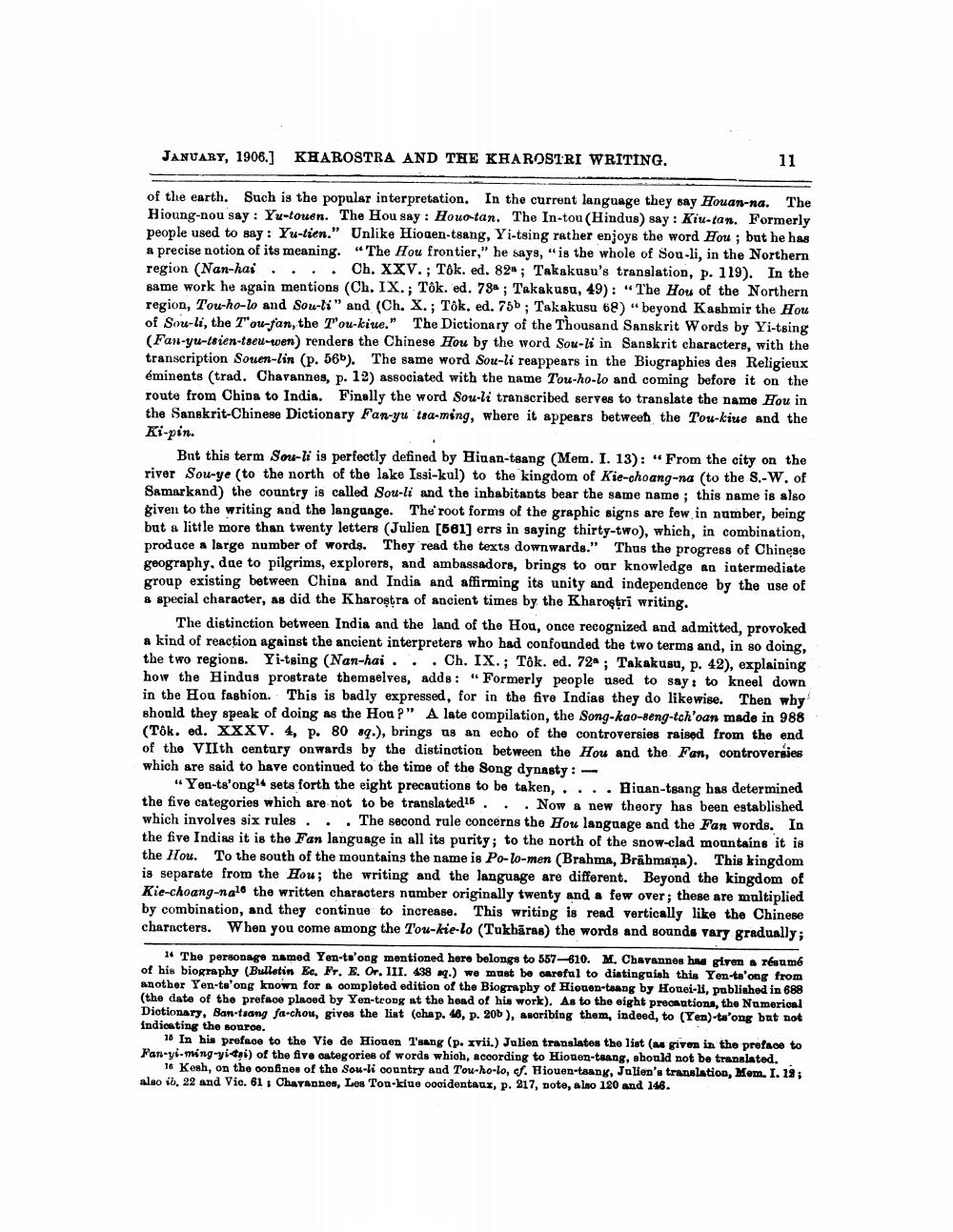________________
JANUARY, 1906.] KHAROSTRA AND THE KHAROSTRI WRITING.
of the earth. Such is the popular interpretation. In the current language they say Houan-na. The Hioung-nou say : Yu-touen. The Hou say: Houo-tan. The In-tou (Hindus) say: Kiu-tan. Formerly people used to say: Yu-tien." Unlike Hiogen-tsang, Yi-tsing rather enjoys the word Hou ; but he has a precise notion of its meaning. “The Hou frontier," he says, "is the whole of Sou-li, in the Northern region (Nan-hai..Ch. XXV. ; Tôk. ed. 82*; Takakusu's translation, p. 119). In the same work he again mentions (Ch. IX.; Tôk. ed. 784 ; Takakusu, 49): "The Hou of the Northern region, Tou-ho-lo and Sou-li" and (Ch. X. ; Tôk. ed. 750 ; Takakusu 68) " beyond Kashmir the Hou of Sou-li, the T'ou-fan, the Tou-kiue." The Dictionary of the Thousand Sanskrit Words by Yi-tsing (Fan-yu-tsien-tseu-wen) renders the Chinese Hou by the word Sou-li in Sanskrit characters, with the transcription Souen-lin (p. 566). The same word Sou-li reappears in the Biographies des Religieux éminents (trad. Chavannes, p. 12) associated with the name Tou-ho-lo and coming before it on the route from China to India. Finally the word Sou-li transcribed serves to translate the name Hou in the Sanskrit Chinese Dictionary Fan-yu tra-ming, where it appears between the Tou-kiue and the Ki-pin.
But this term Soru-li is perfectly defined by Hiuan-tsang (Mem. I. 13): “From the city on the river Sou-ye (to the north of the lake Issi-kul) to the kingdom of Kie-choang-na (to the S.-W. of Samarkand) the country is called Sou-li and the inhabitants bear the same name; this name is also given to the writing and the language. The root forms of the graphic signs are few in number, being but a little more than twenty letters (Julien [561] errs in saying thirty-two), which, in combination, produce a large number of words. They read the texts downwards." Thus the progress of Chinese geography, due to pilgrims, explorers, and ambassadors, brings to our knowledge an intermediate group existing between China and India and affirming its unity and independence by the use of & special character, as did the Kharoştra of ancient times by the Kharoştri writing.
The distinction between India and the land of the Hou, once recognized and admitted, provoked a kind of reaction against the ancient interpreters who had confounded the two terms and, in so doing, the two regions. Yi-tsing (Nan-hai ... Ch. IX.; Tôk. ed. 72; Takakusu, p. 42), explaining how the Hindus prostrate themselves, adds: "Formerly people used to say: to kneel down in the Hou fashion. This is badly expressed, for in the five Indias they do likewise. Then why should they speak of doing as the Hou?" A late compilation, the Song-kao-Beng-tch'oan made in 988 (Tôk. ed. XXXV. 4, p. 80 sq.), brings as an echo of the controversies raised from the end of the VIIth centary onwards by the distinction between the Hou and the Fan, controversies which are said to have continued to the time of the Song dynasty : -
"Yen-ts'ong! sets forth the eight precautions to be taken, .... Bigan-tsang has determined the five categories which are not to be translated16 ... Now a new theory has been established which involves six rules ... The second rule concerns the Hou language and the Fan words. In the five Indias it is the Fan language in all its purity; to the north of the snow-clad mountains it is the Hou. To the south of the mountains the name is Po-lo-men (Brahma, Brāhmaṇa). This kingdom is separate from the Hou; the writing and the language are different. Beyond the kingdom of Kie-choang-nalo the written characters number originally twenty and a few over; these are multiplied by combination, and they continue to increase. This writing is read vertically like the Chinese characters. When you come among the Tou-kie-lo (Tukhāras) the words and sounds vary gradually;
#4 The personage named Yen-to'ong mentioned here belongs to 557-610. M. Chavannes has given a résumé of his biography (Bulletin Ec. Fr. E. Or. III. 438 q.) we must be careful to distinguish this Yen-ta'ong from another Yen-to'ong known for completed edition of the Biography of Hionen-taong by Honei-li, published in (the date of the preface placed by Yen-teong at the head of his work). As to the eight precautions, the Numerical Dictionary, Ban-tsang fa-chou, gives the list (chap. 46, p. 206 ), asoribing them, indeed, to (Yen)-ta'ong but not indicating the souroe.
16 In his preface to the Vie de Hiouen l'sang (p. xvii.) Julien translates the list (as given in the preface to Fan-yi-ming-yi-tai) of the five categories of words which, according to Hionen-tsang, should not be translated..
16 Kesh, on the confines of the Sou-li country and Tou-ho-lo, cf. Hiouen-tsang, Julien's translation, Mem. I. 19; also ib. 22 and Vic. 61, Chayannen, Les Tou-kius oocidentaux, p. 217, note, also 120 and 146.




